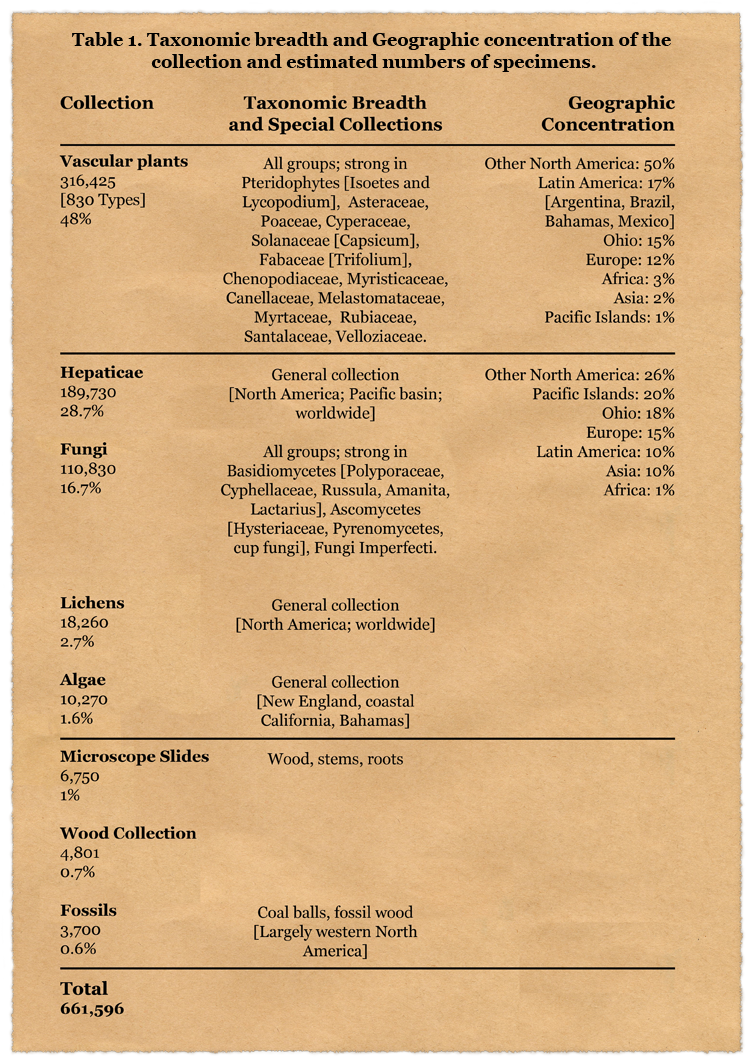Taxonomic and Geographic Breadth of the Collection
Herbarium MU is an extremely broad collection, both taxonomically and geographically (see Table 1). Holdings include specimens of vascular plants, bryophytes, fungi, algae, vascular plants, and plant fossils. In addition, MU houses a wood specimen collection, wax-embedded wood, stem, and root materials, and a microscope slide collection of wood sections, stem sections, root sections, and pollen. This year, a collection of silica gel dried leaf material was established as a DNA bank, which will be available to researchers upon request, ultimately through the herbarium web page. Geographic distribution of the collection is worldwide.

The collection contains over 660,000 specimens, with vascular plants and hepatics the largest portions, at 48% and 29% respectively. The fungal collection represents about 17%, with the remainder consisting of lichens, algae, a microscope slide collection, wood samples, and fossils. Herbarium MU is the largest collection in Ohio, the next largest being OS (Ohio State University), and is among the top 20 in the United States (from Holmgren and Holmgren 1998). MU houses important vascular plant collections, such as the W. Hardy Eshbaugh Capsicum collection, ferns from SE Asia, alpine plants from Iryan Jaya, fern allies (Isoetes, Lycopodium, Selaginella), Fabaceae (Astragalus, Cercis, Lupinus, Trifolium), and, in addition to Ohio and North American collections, large collections from Argentina, Bahamas, Brazil, South Africa, and Ukraine. Important collectors include R. D. A. Bayliss, E. Belk, M. F. Spencer, M. E. Jones, J. L. Riddell, N. Goodall, F. W. Anderson, G. Hatschbach, F. D. Kelsey, P. Train, C. G. Pringle, G. T. Jones, and F. O. Grover.
The hepatic collection is rich in both mosses and liverworts, and is worldwide in scope. About 25% of the collection is New World, ca. 50% from the Pacific basin, and the remainder from Europe, Asia, and Africa. Important collectors include D.C. Eaton, L.F. Koch, H.A. Miller, D.R. Smith, and H. Whittier.
The fungal collection is rich in North American specimens, and also contains material from Latin America, Europe, Asia, Africa, and Pacific Islands. Holdings include good collections of polypore fungi, deuteromycetes, and slime molds. Important collectors include F.W. Anderson, W.B. Cooke, J.B. Ellis, B.M. Everhart, B. Fink, F.O. Grover, F.D. Kelsey, M.L. Lohman, W.A. Murrill, L.O. Overholts, and L.E. Wehmeyer.
The lichen collection includes specimens from throughout North America, with moderate holdings from Latin America, Europe, Africa, and Asia. Important collectors include W.B. Cooke, B. Fink, H.E. Hasse, E. Tuckerman, and A. Zahlbruckner. The remainder of the holdings represents algae from eastern North America, California, and the Caribbean, a wood collection amassed by C. Heimsch, and microscope slides of wood, stems, and roots of vascular plants from the research of C. Heimsch and T.K. Wilson. The fossil specimens are largely from western North America, along with coal balls and fossil wood collected by W.H. Blackwell and others.
Since 1993, the collection has nearly doubled in size (with a 50% increase since 1998), and holdings in Latin America, Africa, Asia, and the Pacific basin have increased by nearly 500%. In the last five years, the greatest increase has been in the vascular plant holdings, with a growth rate of over 34%.





